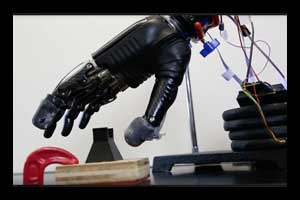- Home
- Editorial
- News
- Practice Guidelines
- Anesthesiology Guidelines
- Cancer Guidelines
- Cardiac Sciences Guidelines
- Critical Care Guidelines
- Dentistry Guidelines
- Dermatology Guidelines
- Diabetes and Endo Guidelines
- Diagnostics Guidelines
- ENT Guidelines
- Featured Practice Guidelines
- Gastroenterology Guidelines
- Geriatrics Guidelines
- Medicine Guidelines
- Nephrology Guidelines
- Neurosciences Guidelines
- Obs and Gynae Guidelines
- Ophthalmology Guidelines
- Orthopaedics Guidelines
- Paediatrics Guidelines
- Psychiatry Guidelines
- Pulmonology Guidelines
- Radiology Guidelines
- Surgery Guidelines
- Urology Guidelines
New 'e-dermis' brings sense of touch, pain to prosthetic hands

Engineers from Johns Hopkins University have developed a novel e-dermis in an effort to restore a real sense of touch for amputees through prosthetic fingertips. The work was published in the journal Science Robotics.
Amputees often experience the sensation of a "phantom limb", a feeling that a missing body part is still there. When layered on top of prosthetic hands, this e-dermis brings back a real sense of touch through the fingertips.
E-dermis recreates a sense of touch as well as pain by sensing stimuli and relaying the impulses back to the peripheral nerves. It is made of fabric and rubber laced with sensors to mimic nerve endings.
"After many years, I felt my hand, as if a hollow shell got filled with life again," says the anonymous amputee who served as the team's principal volunteer tester.
The e-dermis enables its user to sense a continuous spectrum of tactile perceptions, from light touch to painful stimulus. The team created a "neuromorphic model" mimicking the touch and pain receptors of the human nervous system, allowing the e-dermis to electronically encode sensations just as the receptors in the skin would. Tracking brain activity via electroencephalography(EEG), the team determined that the test subject was able to perceive these sensations in his phantom hand.
The researchers then connected the e-dermis output to the volunteer by using a noninvasive method known as transcutaneous electrical nerve stimulation or (TENS). In a pain-detection task, the team determined that the test subject and the prosthesis were able to experience a natural, reflexive reaction to both pains while touching a pointed object and non-pain when touching a round object.
According to the engineers, it is possible to restore a range of natural, touch-based feelings to amputees who use prosthetic limbs. The ability to detect pain could be useful, for instance, not only in prosthetic hands but also in lower limb prostheses, alerting the user to potential damage to the device. Human skin contains a complex network of receptors that relay a variety of sensations to the brain.
"We've made a sensor that goes over the fingertips of a prosthetic hand and acts like your own skin would," says Luke Osborn, a graduate student in biomedical engineering. "It's inspired by what is happening in human biology, with receptors for both touch and pain.
"This is interesting and new," Osborn said, "because now we can have a prosthetic hand that is already on the market and fit it with an e-dermis that can tell the wearer whether he or she is picking up something that is round or whether it has sharp points."
"Pain is, of course, unpleasant, but it's also an essential, protective sense of touch that is lacking in the prostheses that are currently available to amputees," he says. "Advances in prosthesis designs and control mechanisms can aid an amputee's ability to regain lost function, but they often lack meaningful, tactile feedback or perception."
The e-dermis conveys information to the amputee by stimulating peripheral nerves in the arm which is done by electrically stimulating the amputee's nerves in a non-invasive way, through the skin.
"For the first time, a prosthesis can provide a range of perceptions, from fine touch to noxious to an amputee, making it more like a human hand," says Thakor, co-founder of Infinite Biomedical Technologies, the Baltimore-based company that provided the prosthetic hardware used in the study.
Osborn said that the e-dermis is not sensitive to temperature--for this study, the team focused on detecting object curvature (for touch and shape perception) and sharpness (for pain perception). The e-dermis technology could be used to make robotic systems more human, and it could also be used to expand or extend to astronaut gloves and space suits.
The e-dermis was tested over the course of one year on an amputee The researchers plan to develop the technology further and provide more meaningful sensory information to amputees so that it can be used on a mass scale.
For more reference log on to http://dx.doi.org/10.1126/scirobotics.aat3818

Disclaimer: This site is primarily intended for healthcare professionals. Any content/information on this website does not replace the advice of medical and/or health professionals and should not be construed as medical/diagnostic advice/endorsement or prescription. Use of this site is subject to our terms of use, privacy policy, advertisement policy. © 2020 Minerva Medical Treatment Pvt Ltd